Jaipur, also called the Pink City, is one of the three cities of the “Golden Triangle” in India, next to Delhi and Agra. Jaipur is a less chaotic town with 3 million inhabitants. The attractions of Jaipur are relatively close to each other, but still, there are enough places of interest to spend two days in Jaipur. I have visited Jaipur plenty of times. Based on my experience, I made a detailed guide about the best places to visit in Jaipur in two days.
- How to travel from Delhi to Jaipur
- The places to visit in Jaipur on day 1
- The places to visit in Jaipur on day 2
- The brief story of Jaipur, the Pink City
- The Jaipur royal family
- Entrance ticket – how to save money
- The most famous historical sites of Jaipur
- Other places to visit near Jaipur
- What are the best things to do at night in Jaipur
- Where to taste the best masala tea and coffee in Jaipur
- Where to go shopping in the Pink City?
- The festivals of Jaipur
How to travel from Delhi to Jaipur
- Bus: The Maharana Pratap Interstate Bus Terminal at Kashmere gate is the central metro station in India. It only serves state buses. If you want to catch a private bus, then book your ticket via www.redbus.com. You will be informed where to wait for the bus, for example at the pillar under the metro line. (Do not laugh, this is India).
- Train: Take a train from Delhi Shahdara Railway station to Jaipur (500- 600 INR).
Buy your train ticket here: www.icrtc.co.in
Double-decker train: The double-decker train leaves Sarai Rohilla Railway Station and reaches Jaipur in 4 ½ hours, 450 INR, but is more congested.
- Take a private or shared taxi with Ola or Uber from Delhi to Jaipur (3000 INR).
The places to visit in Jaipur on day 1
- Amber Fort (old royal fort and palace)
- Jal Mahal (photo stop)
- Jaigarh or Nahargarh fort
- City palace (royal palace)
- Take a 30-40 minutes bicycle rickshaw ride through the city
- Jantar Mantar (observatory)
- Hawa Mahal (Palace of winds)
- Albert Hall (photo stop)
- Watch a movie in Raj Mandir
The places to visit in Jaipur on day 2
- Gaitor (Royal tombs of maharajas)
- Galta (Monkey temple)
- Go shopping in the Bazaars (Bapu bazaar for textile, Johri bazaar for jewelry)
- Birla temple (white marble Hindu temple)
- Have a sunset view in Nahargarh fort and dine in the Padao restaurant
The brief story of Jaipur, the Pink City
Jaipur is the capital of the Rajasthan state, also called the Pink city. They painted the entire old town in pink to honor Prince Albert (who later became King Edward VII) during his visit. Despite being called Pink City, the actual color looks more like orange.
Pin it for later!
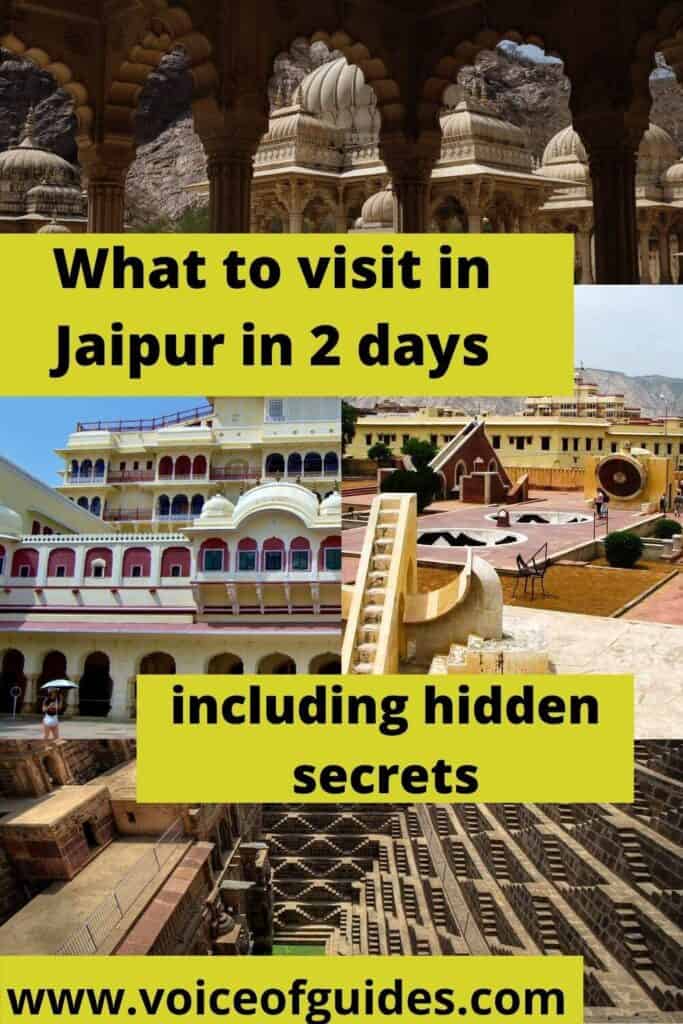
Jaipur is also the city of gems and jewelry with around 2000 jewelry shops. They benefit from the abundant precious and semi-precious stones found in the surrounding Aravalli mountain range. Jaipur sells jewelry to every part of India and to other countries too. It is the best place to buy top-quality jewelry for a reasonable price.
Jai Singh II, the most talented astronomer of his time, founded the city in 1727. He built a modern town and placed his observatory with large instruments in its center, some of which are still functioning today. Jaipur got its name after the founder, Jai Singh II.
In the times of British rule, the Rajasthan state was the center of the princely states governed by maharajas. The maharajas were trustworthy supporters of the colonists. In return for their support, they could pursue an opulent lifestyle. They spent their time tiger hunting, playing polo, or celebrating parties in one of the royal palaces.
The best local tours in and around Jaipur
Polo sport in the royal family
The polo sport has been the most popular hobby of the royal families until now. Man Singh II was an exceptionally talented player and won the world cup with his team in 1933. He married Gayatri Devi, one of the ten most beautiful women in the world (according to the Vogue magazine). She had a turbulent life after her marriage. When Indira Gandhi introduced a state of emergency in 1975, she imprisoned many journalists and supporters from the opposition, including Gayatri Devi, who was a member of the Parliament. They falsely charged her with violation of tax laws. She spent five months in jail and shortly after she wrote down her experiences in the book “The Princess remembers”.
Tip: Read the book “A Princess remembers” by Gayatri Devi
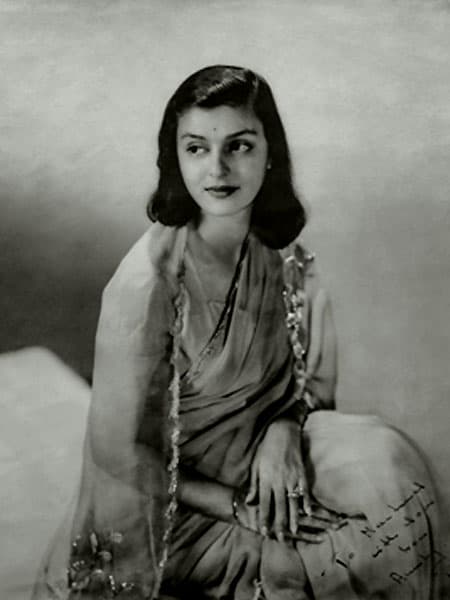
The Jaipur royal family
The current Maharaja of Jaipur is the only 22-year old Padmanabh Singh (born in 1998). His nomination as the heir to the throne became a family scandal. The former maharaja was his grandfather, Bhawani Singh, who died in 2011.
Bhawani Singh had no sons, just a daughter, Diya Kumari. She is a member of the Indian Parliament and the BJP ruling party.
Royal families always intermarry in India to keep the “royal lineage”. But Diya Kumari fell in love with the accountant of the royal family. She knew it was wrong and tried to fight her feelings, but in vain.
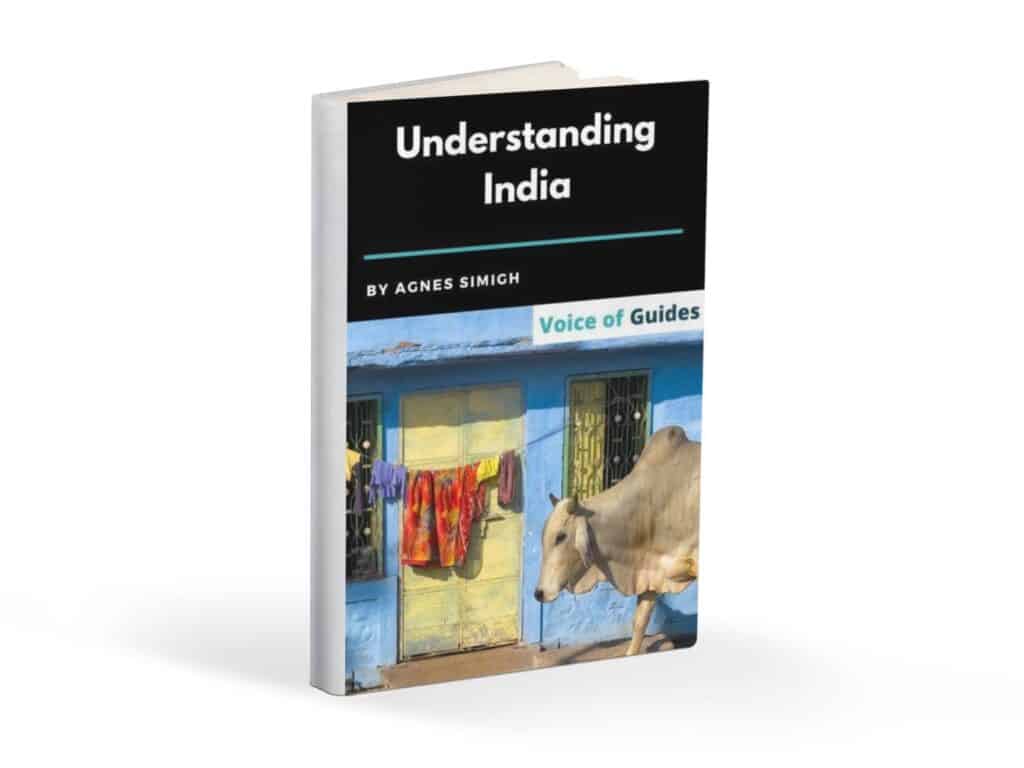
Although everyone in the family, including Maharaja Bhawani Singh, opposed the marriage first, he finally agreed to a low-key ceremony.
Before he died, he had to decide on his successor. To everybody’s surprise, he appointed his grandson. He could have chosen anybody else from the royal family, but he stood up for his decision to break the royal lineage. Although the royal title, “Maharaja” was abolished decades ago, Padmanabh was traditionally “crowned” after the death of Bhawani Singh at the age of only 13 in 2011. He remained under the guardianship of his grandmother till he turned 18. Sadly, after overcoming all these obstacles, his parents got divorced not long ago.
Entrance ticket – how to save money
If you have two days in Jaipur and you plan to visit many historical sites, you can spare some money by buying combined tickets. It costs 1000 INR for foreigners, 300 INR for Indians and is valid for the following monuments:
- Amber Fort
- Albert Hall
- Hawa Mahal
- Jantar Mantar
- Nahargarh Fort
- Sisodia Rani Ka Bagh
The most famous historical sites of Jaipur
1. Amber Fort – The highlight of Jaipur
The fairy-tale -like palace is built against rocky cliffs. The clay-colored massive walls withstood attacks, while the royal palaces served as comfortable retreats for the Maharaja and his consorts.
The Amber Fort was the royal seat of the Kachhwaha dynasty. Jaipur was one of the hundreds of princely states of the historic Rajputana region. Although the fort dates back to the 11th century, the current palaces were built at the end of the 16th century and beginning of the 17th century. The inner gardens, pavilions as well as a beautiful mirror palace (Sheesh Mahal) connected with the labyrinth of corridors are jaw-dropping. Amber Fort will be the highlight of your visit to Jaipur.
How to get to the fort:
- Take a jeep from the parking up to the entrance of the fort (500 INR including tip up and down)
- Go up with the elephant (2 persons take a seat on one elephant, 1100 INR +100 INR tip)
Even if the boards at the elephant stand indicate “Please no tip”, you will have to give. Why? The mahout (elephant driver) will not let you get off the elephant until you give him some tip. It is 100 INR per elephant for two persons. He will beg for more, but the 100 INR will be just fine! The elephant ride is only one way. You can walk back or take a jeep on the way down.
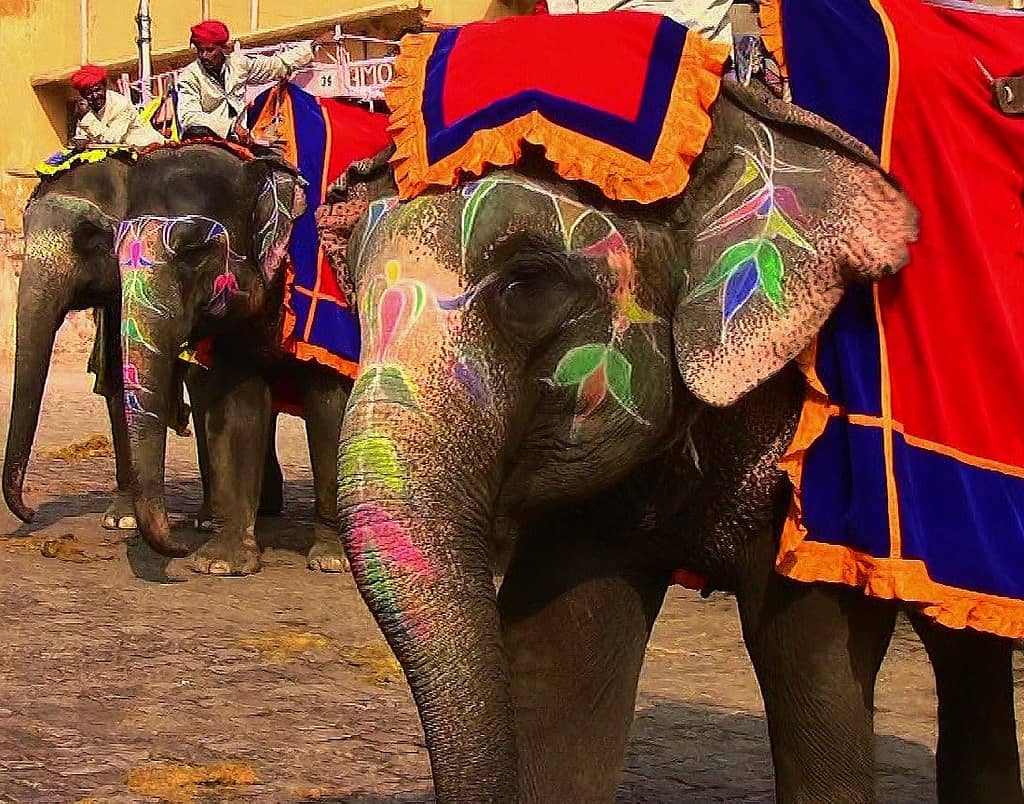
Important: There may be a long queue for the elephants, and you have to wait up to an hour. If you are lucky, you get to the top of the elephant stand within 10-15 minutes. The elephants are only “working” in the morning. If you arrive around 11 am, you may not get any elephants because they already completed their daily five rounds. It all depends on the number of visitors. Usually, 7:30 am-8:00 am is a good time to avoid long queues.
Tip: Photographers take photos of everyone as the elephants are marching up the serpentines. I do not know how it is physically possible, but they will come with the printed pictures already when you get off the elephants 10 minutes later. Or at the latest when you are about to leave the palace. Do not look for them. They will find you! Indians have an incredible talent to spot the people. They will start with crazy prices but go down to 50 INR/photo. That is a reasonable price.
Entrance fee: 600 INR
Opening hours: 8:30 am – 5:30 pm
The best local tours in and around Jaipur
2. Jal Mahal – Water Palace
The Jal Mahal Water Palace was once the hunting palace of the royal family. Now it stands empty in the middle of a lake. There are constant plans to build a bridge and make a café inside, but so far it has not been realized. Still, the stunning view of the palace reflected in the water makes it a perfect stop for a photo.
Tip: There are several sellers around the photography place, where you can buy souvenirs. There are “magic boys or magic girls” approaching you with their bags. They are exceptionally talented in showing magic tricks with coins, balls, and cups and deserve some tip. The only problem is that they skip school to earn money with that. But as long as people are paying for the show, they will not be motivated to go to school. At the same time, they are providing for their families. So, the vicious circle keeps on turning.
3. City Palace of Jaipur – the “Versailles of India”
Maharaja Jai Singh II decided to build a city next to Amber and move the royal seat from Amber to Jaipur. The City Palace is not a well-protected fort anymore. “The Versailles of India” is a complex of reception halls and private residences that have been converted into museums today. The royal family still lives in one section of the City Palace.
The textile museum has some interesting pieces: the polo uniform of Man Singh II, the famous polo player who won the World Cup, and the enormous underwear of Madho Singh I, who weighed 240kg.
You will also see the biggest silver urns (capacity of 4000 l, 1.60 m high, and with a weight of 345 kg each). Madho Singh II had these silvers urns made to carry enough holy Ganga water for his 3-months-stay in Great Britain, where he attended the coronation ceremony of Edward VII. As a pious Hindu, he refused to use the European water for drinking and religious ceremonies. So he decided to carry sufficient Ganga water for his trip.
Entrance fee: 500 INR. For an extra 2500 INR, you can visit the private apartments of the Jaipur royal family. It has been closed for the public until recently!
Opening hours: 9:30 am- 5:00 pm
Interesting: At the end of 2019, the Jaipur royal family put their Gudliya suite on Airbnb for 8000$/night. The suite has an own kitchen, a lounge, and an indoor pool. The guests get several extra services. A chauffeur drives them to the palace from the airport, a private butler and a tour guide stay at their disposal. They can have dinner on the terrace with a nice view of the Aravalli hills and the surrounding forts. Princess Diana, Bill Clinton, and Jacqueline Kennedy are among the famous guests who stayed in the royal suite before. The royal family uses the profits to support local women.
Tip: A great way to discover the city is to go on a 30-40 minutes bicycle rickshaw ride from the City Palace through the Pink City.
Tip: Choose either Jaigarh fort or Nahargarh for to visit
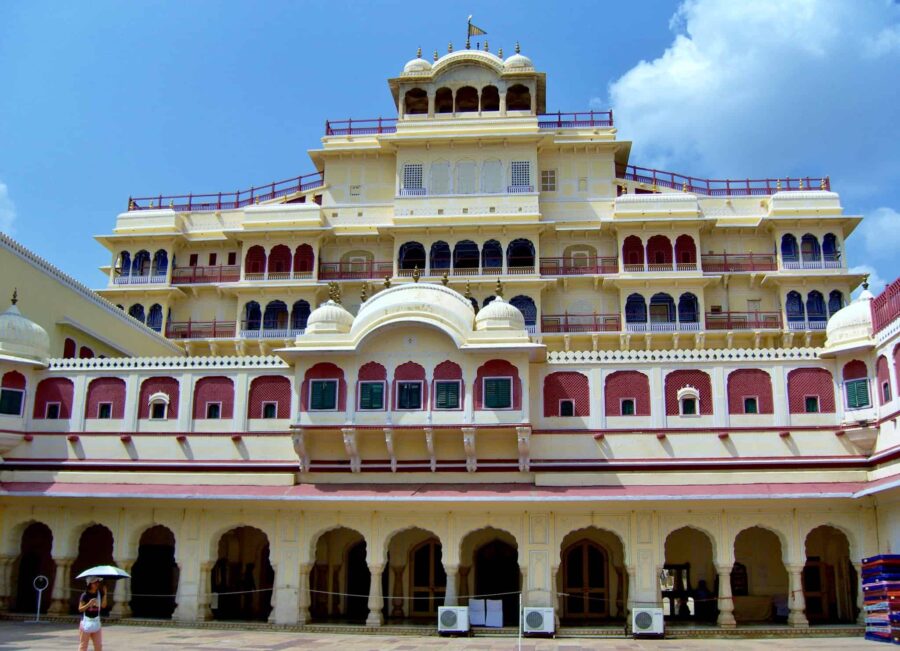
4. Jaigarh Fort – the military fort with the largest cannon on wheels
Winding roads lead up to the Jaigarh fort on the top of the Aravalli mountains. It is a military fort that protected the Amber Fort. The defensive walls run 3 km along the top of the mountain range.
In case of an emergency, the residents could escape through the 4-km long underground tunnel that connected the Amber Fort and the Jaigarh Fort.
The best local tours in and around Jaipur
The Jaigarh Fort functioned as a cannon foundry, a center for artillery production. The largest cannon on wheels in the world, the Jaiwana is the highlight of the visit. The whole canon weighs 150 tons, out of which the barrel alone accounts for 50 tons. Interestingly, they never used it in a battle.
According to a popular legend, once local kings hid their treasures in underground chambers below the water tank in the fort.
People firmly believed in this rumor. When Indira Gandhi started to investigate the financial resources of the royal families during the state of emergency in 1977, she ordered to dig up the water tank to find the hidden treasures. The mission failed, but people still believe the gems are hidden somewhere in the fort.
Entrance fee: 150 INR, 50 INR camera, 200 INR video camera
Opening hours: 9:00 am – 4:30 pm
5. Nahargarh Fort – the best sunset and sunrise view of Jaipur
Jai Singh II built the fort in 1734 primarily as a retreat. The Nahargarh Fort belongs to the skyline of Jaipur, and you can see it from almost anywhere. Although the inner decoration is less impressive than that of the Amber Fort, it is worth a visit for the beautiful view of Jaipur. The nine two-storey private apartments of the royal ladies and the king’s quarter inside the Madhavendra Bhavan palace complex are the highlights. The ramparts of the Nahargarh fort connect as far as to the Jaigarh fort.
The Wax museum: In the Hall of Icons, the wax statues of Bollywood stars and cricket players and other wax statues with traditional Rajasthani dresses welcome visitors.
How to get to the fort:
– If you are fit enough, you can reach the fort on foot within 30 minutes from the Nahargarh Palace Hotel.
– You can take an auto-rickshaw or cab up to the fort.
Opening hours: 10:00 am- 5:30 pm
Entrance fee to the Nahargarh fort: 200 INR for foreigners, 50 INR for Indians
Entrance fee to the wax museum: extra 700 INR for foreigners and 500 INR for Indians
Tip: If you pay an extra 50 INR, you can dine in the Padao restaurant enjoying the perfect panorama.
6. Hawa Mahal – The Palace of Winds
The most iconic monument of Jaipur is the Hawa Mahal. The façade of the palace resembles a crown or a birdcage with 953 tiny holes. The royal ladies had to follow strict rules and could not show their faces to the public. These holes let the cool air pass through and allowed them to observe the daily happenings without being seen. The royal ladies mainly used the palace in summer when it provided a pleasant temperature. Strangely, what you see from the street is the back and not the front of the Hawa Mahal.
Tip: For 50-100 INR, you can climb to the top of the building opposite Hawa Mahal for a better view. Do not just take a photo from the street, but visit the Hawa Mahal from inside too. (You can find the main entrance if you go from the bazaar to the back of the building).
Entrance fee: 200 INR
Opening hours: 9:00 am-5:00 pm
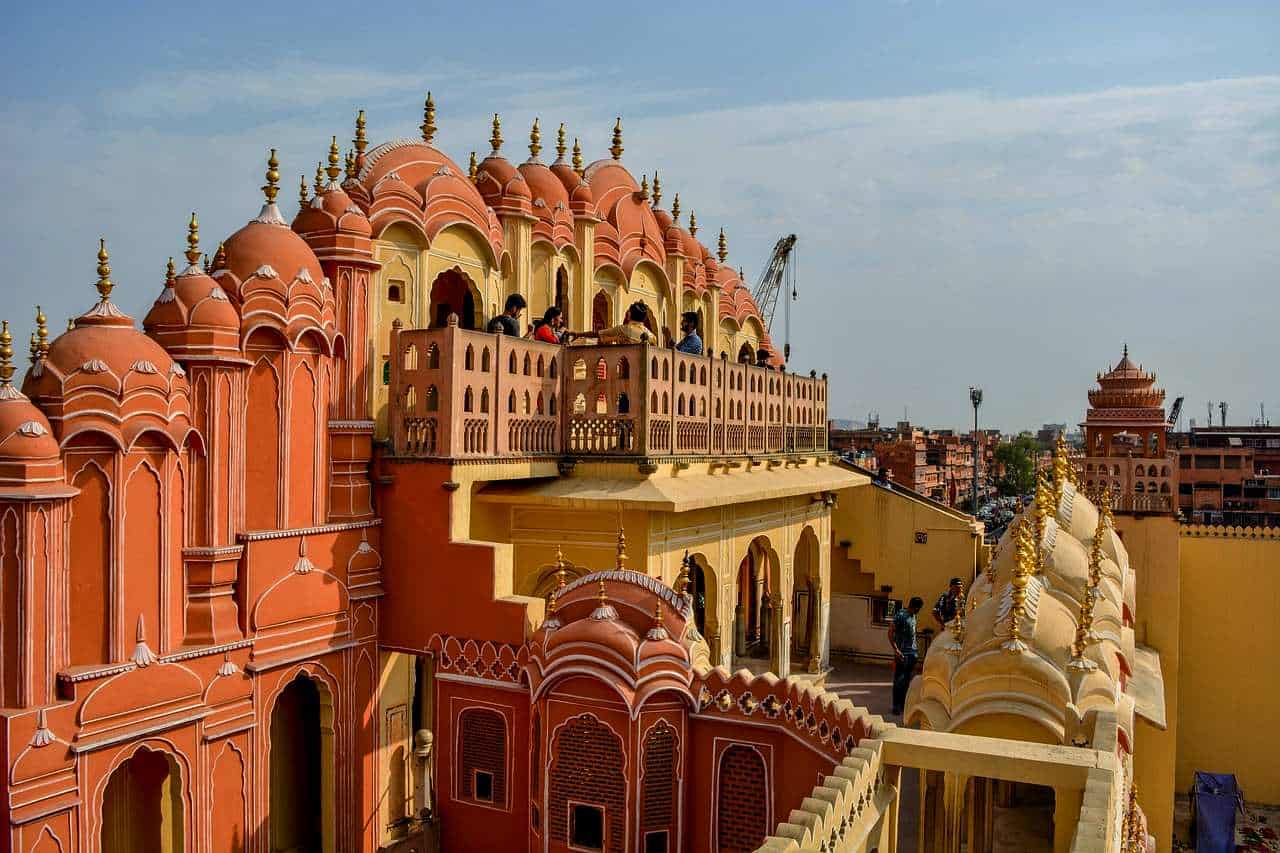
7. Jantar Mantar – the observatory with the largest stone sundial
The founder of Jaipur, Maharaja Jai Singh II was a world-famous mathematician and astrologer. He collected and analyzed all the calculations available about the stars and planets. Jai Singh II concluded that the calculations are not accurate because the instruments were not big enough, and he set up his observatory with 19 monumental structures, each with multiple functions.
One was a sundial that could show the local time of Jaipur with a 20-second accuracy. But he was still not satisfied and constructed a bigger one that could show the local time with a 2-second accuracy. It has become the largest sundial on earth. It still works, and they also use it to anticipate when and with what amount of rain the monsoon arrives that year.
Tip: It is incredible just to see the instruments scattered around, but if you want to understand how they work, you better buy a book in the shop or hire a local guide.
Entrance fee: 200 INR
Opening hours: 9:00 am- 4:30 pm
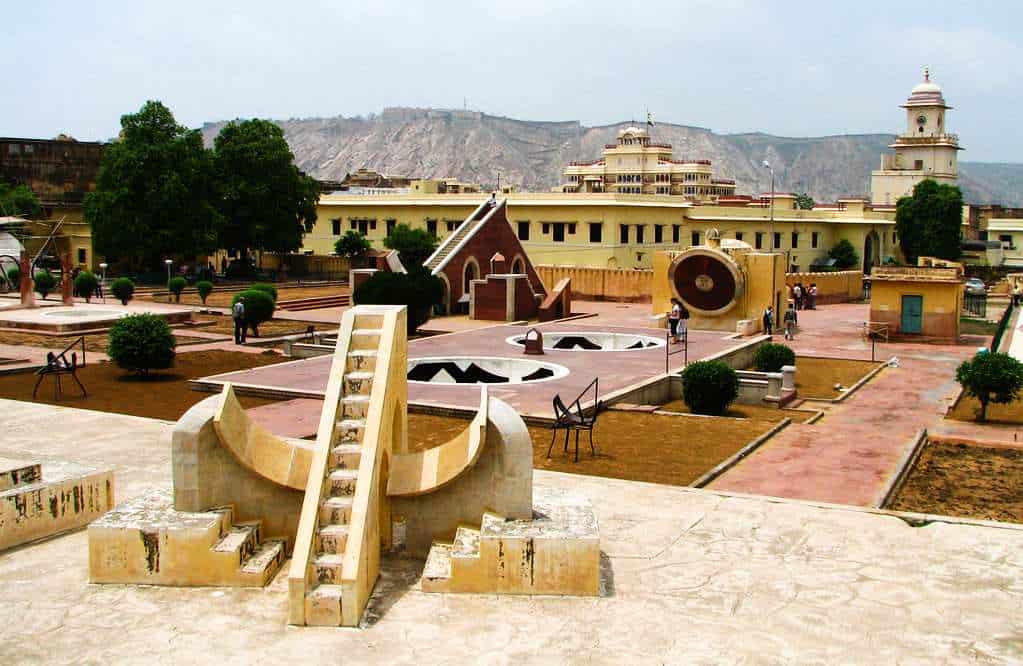
8. Albert Hall Museum- the unique Indo-Saracen style building
The Albert Hall Rajasthani museum was planned to be a town hall, but then it became the State Museum of Rajasthan. The architect, Sir Swinston Jacob combined the European and Indian architectural elements, which resulted in this multi-storey building with several corridors, pavilions, and decorative elements. The museum displays paintings, jewelry, carpets, ivory, stone, metal sculptures, and other Rajasthani artifacts.
Entrance fee: 300 INR
Opening hours: 9:00 am- 6:00 pm
The best itinerary if you have two weeks to spend as a first time visitor in India
9. Gaitor – The royal tombs of the rulers in Jaipur
Although the white marble and sandstone tombs of the royal family are impressive, it is a much less known attraction. Starting with Jai Singh II every Jaipur ruler was cremated at this place. After the ceremony, impressive memorials are built to honor the king. The latest one is that of Bhawani Singh, who died in 2011. There is a separate royal cremation place with the tombs for the royal ladies.
Hindus do not have cemeteries and graves, but the royal family is an exemption. They cremate the bodies according to Hindu traditions but build monumental “chhatris” (pavilion-shaped tombs) on top of the cremation ground. The sandstone or white marble tombs have intricate carvings inside the dome.
Entrance fee: 30 INR
Opening hours: 10:00 am – 5:30 pm
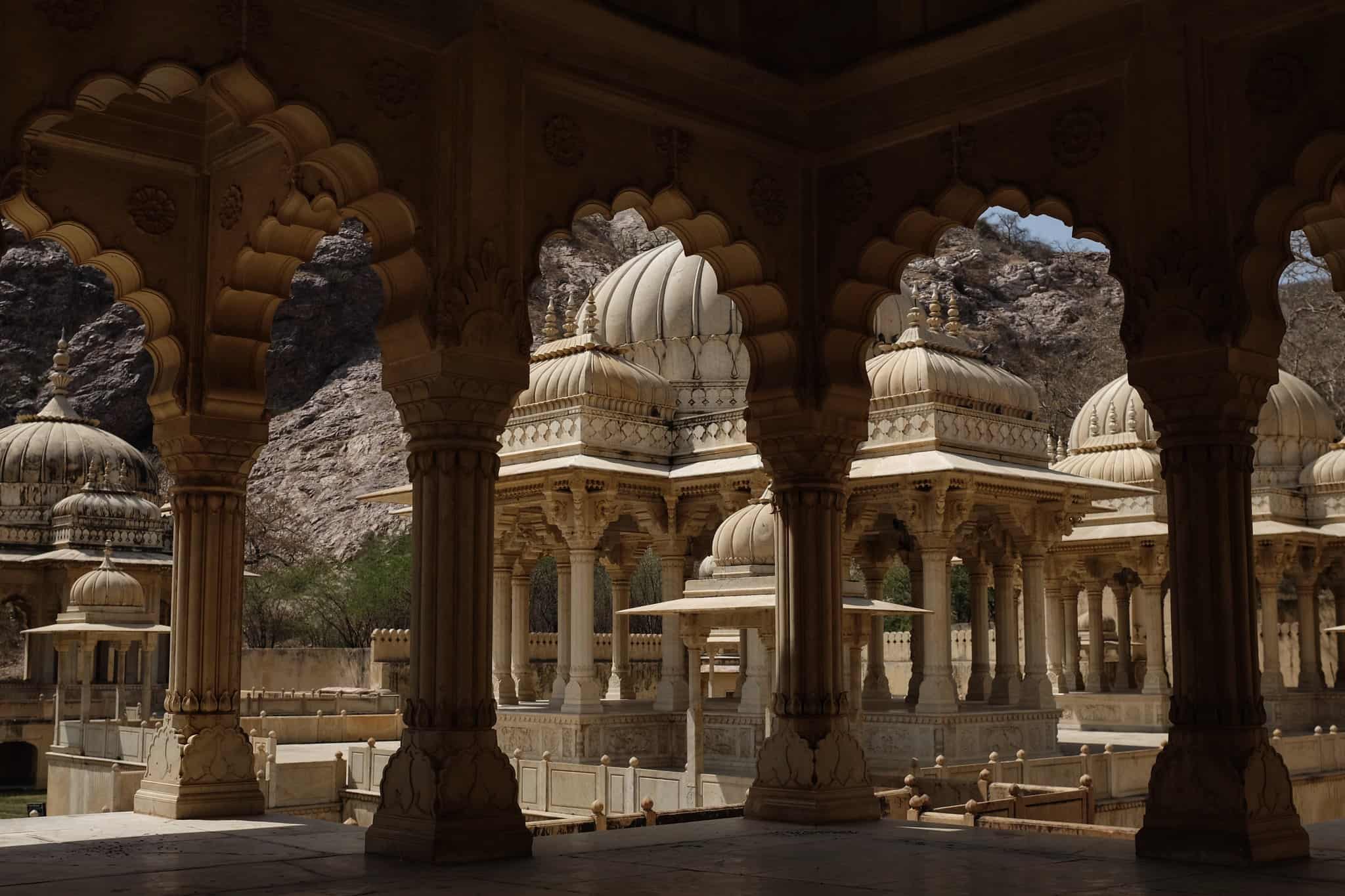
Other places to visit near Jaipur
1. Galta – the holy place with thousands of monkeys
Galta is an ancient Hindu pilgrimage site, where locals come for a holy dip. The legend says that a rock in a cow’s shape is the water source that feeds the seven water tanks. Since the cow is a sacred animal for the Hindus, it will never get dry. A holy man, Saint Galav, meditated here according to local belief. The Gods blessed him with the water that never runs dry. An adventurous forest road with peacocks rambling around leads to Galta. It is a unique place. Shabby palace-like temples and small shrines built against the rocky mountain make up the religious complex. Women and men come here to have a ritual bath and dip in the holy water.
Thousands of monkeys live in the surrounding mountains and descend to the temple during the day. For that, it is also called the Monkey Temple.
Entrance fee: free, Camera fee: 50 INR, video camera fee: 150 INR
Opening hours: 5:00 am – 9:00 pm
2. Sisodia Rani Ka Bagh – a garden of the former queen
Maharaja Jai Singh II built the royal garden as a summer retreat for his second queen. It is a pleasant garden to walk around with Frangipani and palm trees, fountains, and the palace that you can see from the outside. It is not a highlight of your visit to Jaipur but has a relaxing atmosphere and is an ideal shortstop before driving to Galta. Affluent locals often rent the park for family events.
Opening hours: 8:00 am-5:00 pm
Entrance fee: 200 INR
3. Chand Baori – one of the largest and deepest stepwells in India
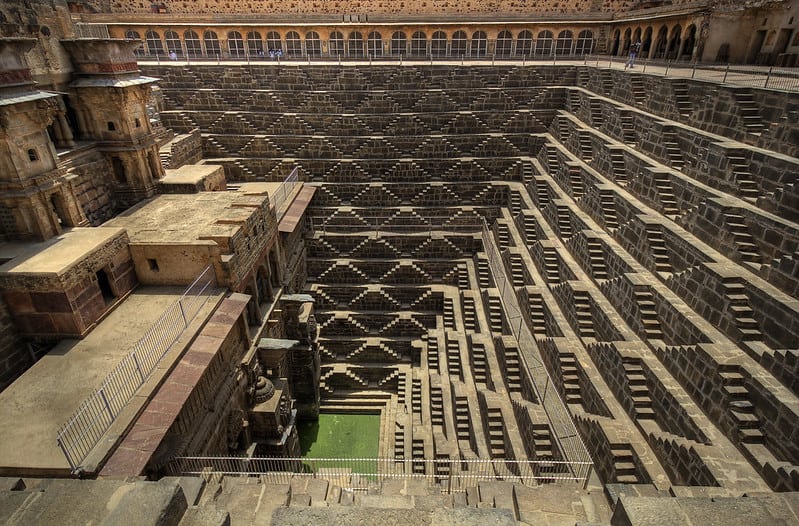
The Harshat Mata temple next to the stepwell is an ancient temple dating back to the 9th century. Muslim rulers destroyed it, but you can still see the stones with beautiful carvings depicting Hindu Gods.
The Chand Baori stepwell is one of the deepest and largest in India. It was crucial in the dry deserted Rasajthan to keep the rainwater as long as possible. They used it for several purposes. For watering, drinking, and for ritual bathing before entering the Harshat Mata temple. They added some pavilions to the stepwell that was a cool retreat in the hot weather.
Opening hours: 7:00 am-5:00 pm
Entrance fee: 200 INR
Tip: If you continue your journey to Agra, do not make an extra 100 kilometers to Chand Baori because it will be on the way. But if you do not head to Agra, do not miss that. It is one of the highlights in the Golden Triangle that is worth the extra time.
Tip: walk around the Abhaneri village. Opposite the stepwell in the local bazaar, a man is making colorful handmade bangles (bracelets).
The best local tours in and around Jaipur
What are the best things to do at night in Jaipur
1. Watch a Bollywood movie in the Raj mandir movie theater
Since its opening in 1976, it has become the symbol of Jaipur. Watch one of the latest movies in a high-class cinema and eat something. In India, you can have a snack or even a hot meal without leaving your seat.
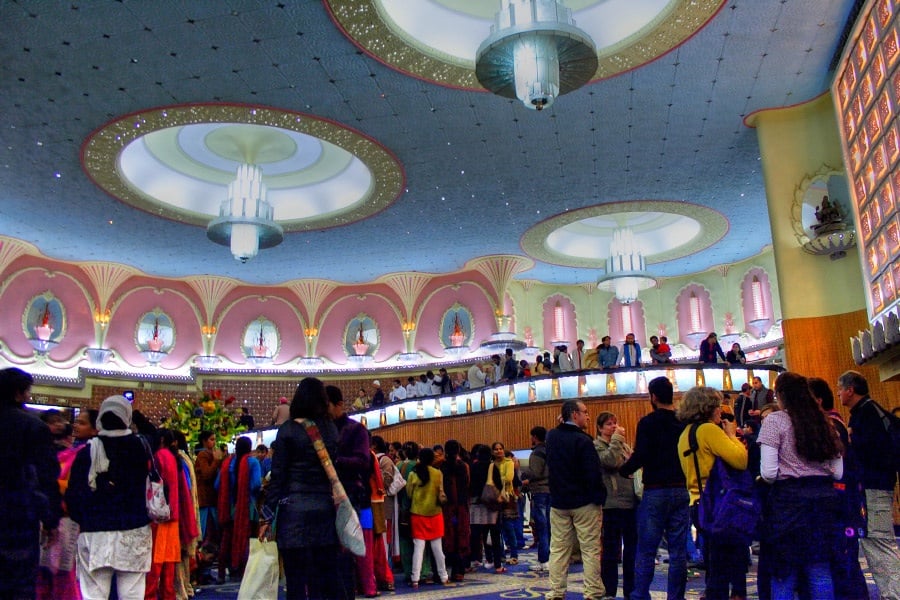
2. Spend the evening in Chokhi Dhani to have some fun and experience the Rajasthani culture
Chokhi Dhani is a Rajasthani cultural village 20 kilometers from Jaipur. It has a great concept to display local culture, music, and dance. There are many activities for children, and you can buy Rajasthani handicrafts, or taste local specialties in a village-style venue. It is quite popular among Indians, but it may be disappointing for some. It is a matter of taste. I found it a fun place where you can mingle with locals and taste Rajasthani specialties. You can also stay for the night in their resort.
Opening hours: 5:30 pm–11:00 pm
Entrance fee: children 450- 800 INR, adults 750-1200 INR, there is an extra fee for meals and rides
3. Enjoy the panorama of the city from Nahargarh Fort
4. Stroll in the Jawahar Circle Garden
Entering through an impressive Rajasthani-style gate, you can walk around the popular Jawahar Circle garden.
Since Jaipur is close to the desert, the government decided to circulate reused water in the garden.
The colorful fountain show of the garden takes place every evening from 07:00 pm to 07:30 pm.
Where to taste the best masala tea and coffee in Jaipur
Taste the best masala tea of Jaipur at Gulab Ji Chaiwala
The owner uses a unique mix of masala for the secret tea. Even celebrities come here for a taste. Location: opposite Ganpati Plaza on MI Road
Indian Coffee House, MI Road – the ICH Jaipur
Try the best coffee of Jaipur in the Indian Coffee House (locals shortly call ICH). The place has the style of the ’70s and serves coffee since 1962. What is the secret of this coffee? They make it fresh and serve in traditional cups. The staff wears Nehru topi or a Pathan turban on their head. Apart from its tasty coffee, it attracts people from all over Jaipur with its South-Indian specialties, the Masala Dosa and Idli Sambhar.
Where to go shopping in the Pink City?
Most tourists go shopping in the central bazaar around the Hawa Mahal. But the sellers try to set very high prices, and they are annoyingly pushy. Those without strong nerves quickly get tired of shopping.
Locals prefer the Bapu Bazaar that is not far from the touristic bazaar. Compared to the one at the City Palace it is very calm. Nobody will push you for shopping. Prices are fixed, or you can bargain a maximum of 10%. It is a great place to buy textile, handicrafts, bangles, and leather products.
If you want to buy top-quality jewelry with precious or semi-precious stones, then head to the Jowri bazaar. This is where locals also do cheap shopping for jewelry.
The festivals of Jaipur
It is always good to come to India during festival time, and Jaipur is famous for its colorful celebrations.
Elephant festival: February-March
The highlight of the festival is the procession of elephants decorated with colorful paintings, saddle cloth, ankles, and bangles on their tusk. Apart from elephants, camels and horses also join the procession. The mahouts sprinkle colorful powders on the elephants. Elephant polo and the tug-of-war between the strongest elephant and a group of men are also among the attractions.
Teej festival – the monsoon festival
You have to be in Jaipur during the monsoon to see the Rajasthani women celebrating the Teej festival. They go to temples dedicated to Goddess Parvati. The day before Teej, women paint their hands with henna in which they hide the name of their husband.
Married women pray for the long life of their husbands, while single girls pray for their marriage. The Teej festival celebrations last three days. On the first day, the married women enjoy the meal their husbands cook for them. Then, they fast the whole day without even drinking. On the third day, they pray and make offerings to Parvati.
Another lovely tradition during the Teej festival is when the ladies are swaying on swings adorned with flowers in their garden. The swings are attached to the tree. They are singing songs about the love of Goddess Parvati and Lord Shiva.
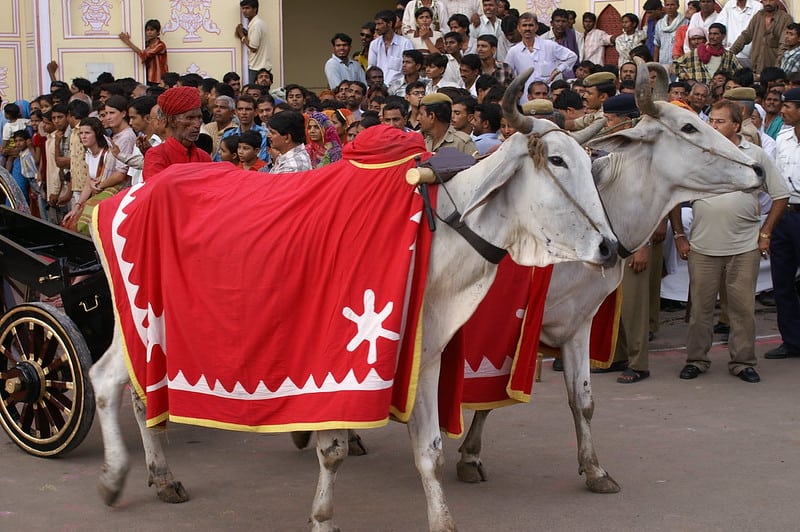
Kite Festival – 14th January
Millions of kites dot the skyline during the kite flying competition. They light up the city with lamps and fireworks. The festival marks the transition of the sun. Even days after, you can see the kites hanging on the trees or lying around.
Jaipur Literature Festival – the largest literary show on earth every January
Renowned Indian and international authors, including Nobel laureates and literature fans, get together during the five-day event in Jaipur. A festival unique to Jaipur calls the attention of the whole world.
Gangaur Festival (March-April)
People celebrate the Gangaur festival in Rajasthan and some other states, but the one in Jaipur is world-famous. Women celebrate Gauri, the wife of Lord Shiva. A procession, with the image of Gauri, starts from the City Palace and then passes through the city. They celebrate spring, harvest, marital fidelity, and childbearing.
Jaipur is one of the highlights of your visit to the Golden Triangle in India where there are so many things to do. Hope you find the article useful and helps you plan your stay in Jaipur.
How to plan your trip to India
Book your flight ticket to India: I always use Google Flights, Skyscanner or Wayaway to find the cheapest flight tickets worldwide. To get an extra 10% for your Wayaway Membership Plus program use my discount code VOG
Insurance to India: Safetywing is an affordable insurance that covers COVID-related issues as well.
: Book your train, bus and domestic ticket in India:
Check Indian Railways website for train tickers, or 12Go which gives you the best option (train, bus, and flight) based on the city of departure or arrival.
Book accommodation in India: Booking.com and Hostelworld.com offer a wide choice of low and higher-budget hotels.
Local tours and tour packages: Viator and GetYourGuide offer transfers and several one or multi-day tours.

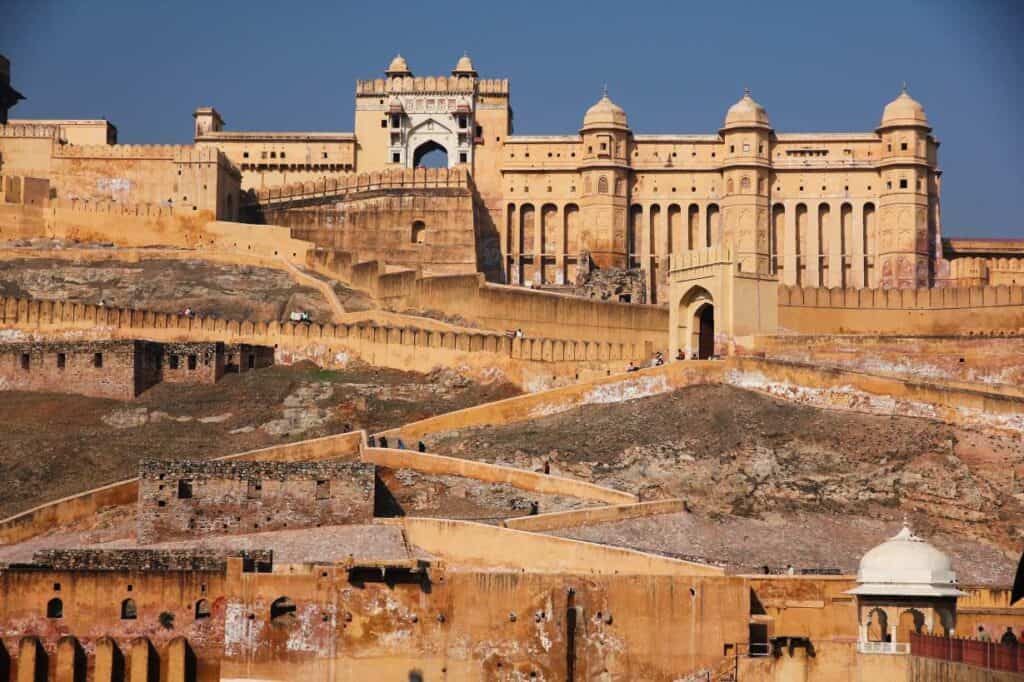

Pingback: The ultimate guide for a two-week itinerary including the Golden Triangle | Voice of Guides